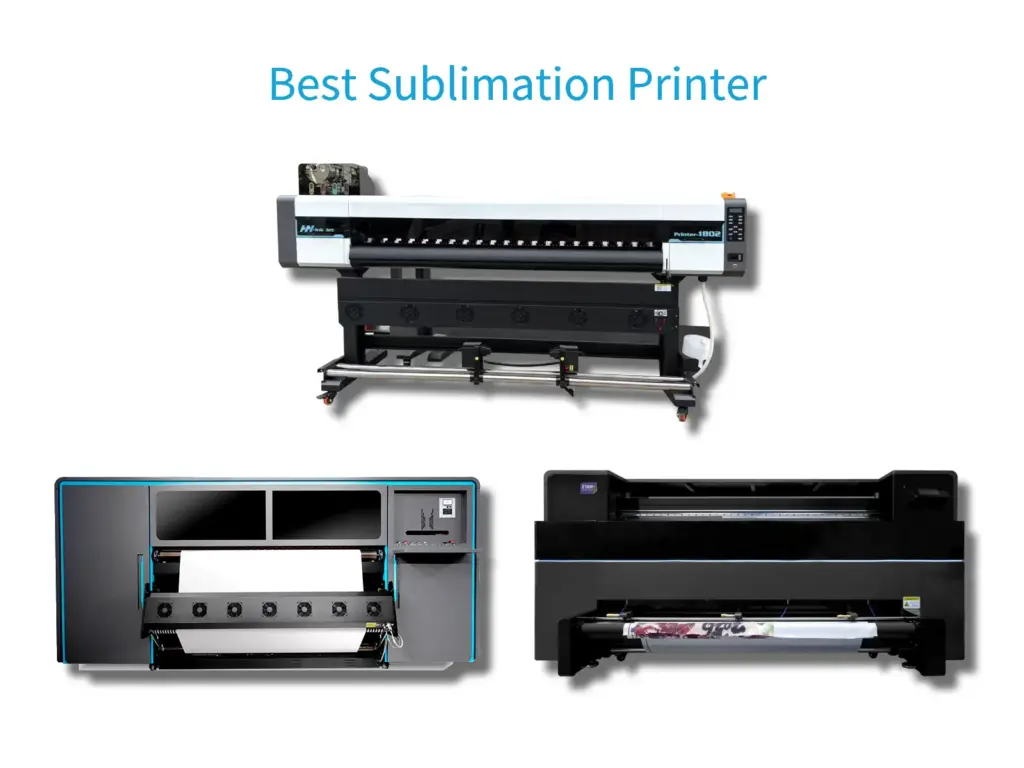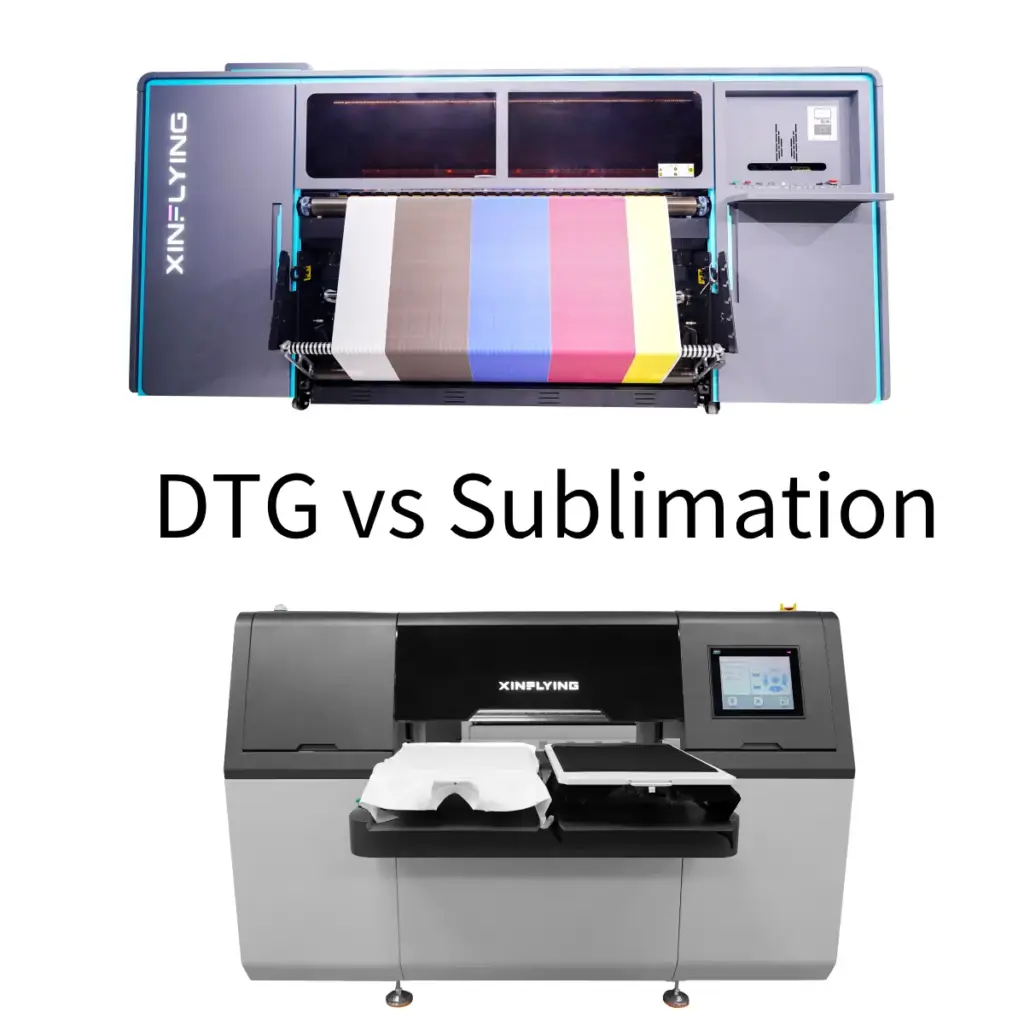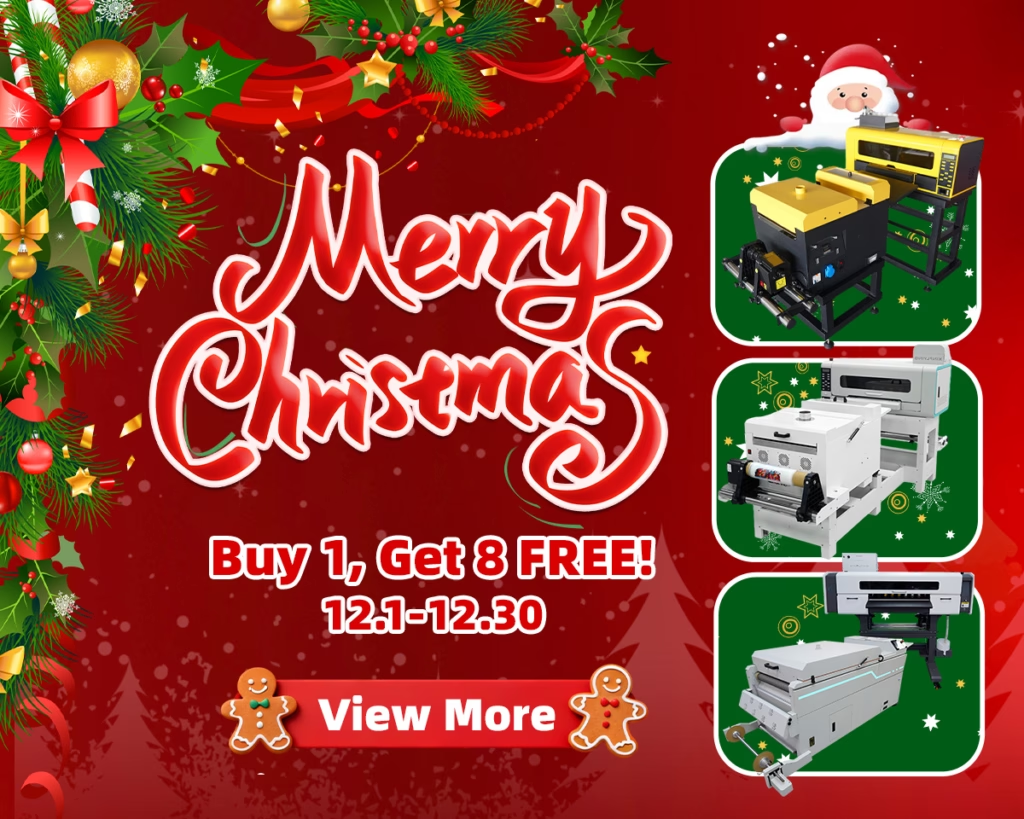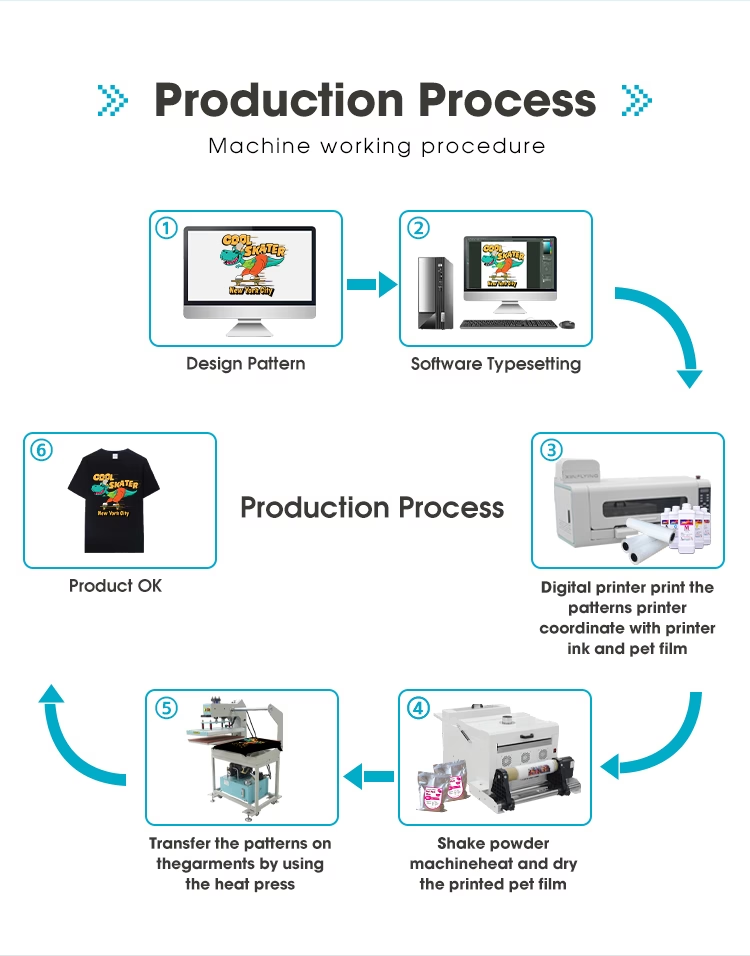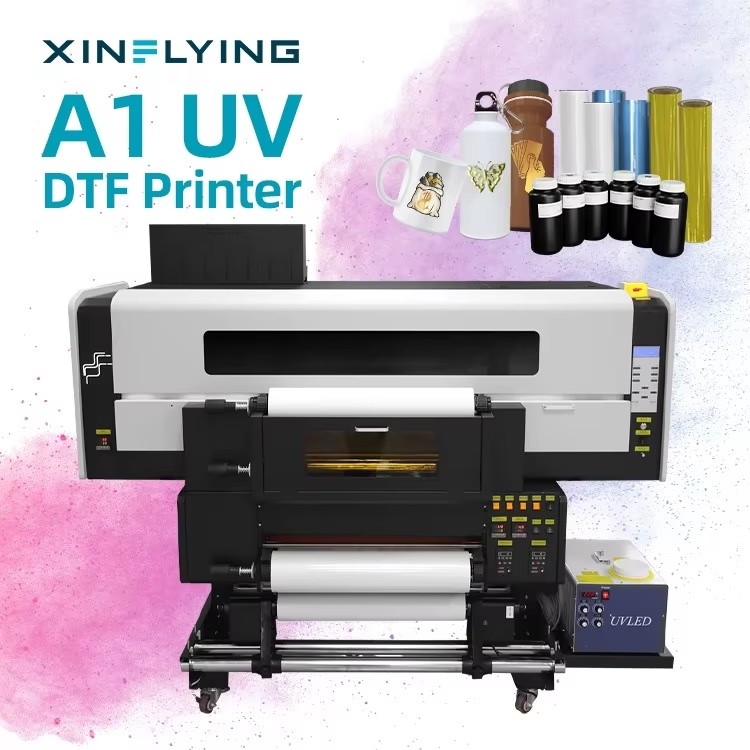เทคโนโลยีการพิมพ์มาไกล, นำเสนอวิธีการต่าง ๆ เพื่อนำภาพมาสู่ชีวิตบนพื้นผิวที่แตกต่างกัน. สองเทคนิคการพิมพ์ยอดนิยมในอุตสาหกรรมปัจจุบันคือ UV DTF Printing และ DTF Printing. ในขณะที่ทั้งสองวิธีให้ผลลัพธ์ที่น่าประทับใจ, พวกเขามีคุณสมบัติที่แตกต่างกันซึ่งทำให้พวกเขาแตกต่าง. ในบทความนี้, เราจะเจาะรายละเอียดของวิธีการพิมพ์แต่ละวิธี, เปรียบเทียบจุดแข็งและข้อ จำกัด ของพวกเขา, และให้คำแนะนำเกี่ยวกับการเลือกวิธีการพิมพ์ที่เหมาะสมสำหรับความต้องการของคุณ.
การพิมพ์ UV DTF คืออะไร?
การพิมพ์ยูวี DTF, ย่อมาจาก Ultraviolet Direct to Film Printing, เป็นเทคโนโลยีที่ทันสมัยที่ช่วยให้การถ่ายโอนภาพคุณภาพสูงไปยังสารตั้งต้นต่างๆ. แตกต่างจากวิธีการพิมพ์แบบเดิมๆ, การพิมพ์ยูวี DTF ใช้รังสีอัลตราไวโอเลต (ยูวี) หมึกที่หายขาดด้วยแสง UV เพื่อความทนทานและสีสันสดใสที่ยอดเยี่ยม.
วิธีใช้เครื่องพิมพ์ UV DTF?
ขั้นตอน 1: ออกแบบบนซอฟต์แวร์ RIP
ประการแรก, เตรียมงานศิลปะด้วยซอฟต์แวร์ RIP บนคอมพิวเตอร์. จากนั้นวาง UV DTF ภาพยนตร์บนแพลตฟอร์มของเครื่องพิมพ์ UV DTF.
ขั้นตอน 2: พิมพ์ลงบนแผ่นฟิล์ม
เติมตลับหมึกด้วยหมึก CMYK ล่วงหน้า, หมึกสีขาว, และเคลือบเงาเพื่อพิมพ์งานออกแบบของคุณบนฟิล์ม UV DTF A.
ขั้นตอน 3: ฟิล์มลามิเนต B
ใส่ฟิล์มพิมพ์ลงในเครื่องลามิเนตเพื่อติดกับฟิล์ม B.
ขั้นตอน 4: ติดฟิล์มบนผลิตภัณฑ์
ลอกฟิล์ม A ของลวดลายออกแล้วติดลงบนรายการที่คุณต้องการพิมพ์. จากนั้นค่อย ๆ ลอกฟิล์ม B ออก, และผลิตภัณฑ์ของคุณเสร็จสิ้นแล้ว.
ข้อดีและข้อเสียของการพิมพ์ UV DTF

ข้อดีของการพิมพ์ UV DTF
- คุณภาพและความคมชัดของภาพสูง
การพิมพ์ UV DTF มีคุณภาพของภาพที่ยอดเยี่ยมพร้อมรายละเอียดที่คมชัดและสีสันสดใส. หมึก UV มีขอบเขตสีที่กว้าง, ช่วยให้สามารถแสดงสีได้อย่างแม่นยำ.
- ขอบเขตสีกว้าง
การพิมพ์ UV DTF ช่วยให้สามารถพิมพ์สีได้หลากหลายบนพื้นผิวต่างๆ, ส่งผลให้มีการออกแบบที่หลากหลายและมีชีวิตชีวา.
- เวลาผลิตที่รวดเร็ว
เมื่อเทียบกับวิธีการพิมพ์แบบดั้งเดิม, การพิมพ์ UV DTF ให้เวลาการผลิตที่เร็วขึ้น. หมึก UV แห้งเกือบจะทันที, ไม่จำเป็นต้องมีระยะเวลาการอบแห้งที่ขยายออกไป.
- ความสามารถในการพิมพ์บนพื้นผิวต่างๆ
การพิมพ์ UV DTF ให้ความยืดหยุ่นในการพิมพ์บนวัสดุที่หลากหลาย, รวมถึงผ้า, พลาสติก, กระจก, และอื่น ๆ. ความเก่งกาจนี้ทำให้เป็นตัวเลือกที่เหมาะสำหรับธุรกิจที่ต้องการกระจายการนำเสนอผลิตภัณฑ์ของพวกเขา.
ข้อ จำกัด ของการพิมพ์ UV DTF
- ค่าใช้จ่ายของหมึกและอุปกรณ์ UV
การพิมพ์ UV DTF ต้องใช้หมึกและอุปกรณ์ UV พิเศษ, ซึ่งอาจมีราคาแพงกว่าเมื่อเทียบกับวัสดุการพิมพ์แบบดั้งเดิม. นอกจากนี้, หมึก UV อาจมีอายุการเก็บรักษาที่สั้นกว่า, ต้องการการเปลี่ยนบ่อยครั้ง.
- ความยืดหยุ่น จำกัด ด้วยวัสดุบางอย่าง
ในขณะที่การพิมพ์ UV DTF สามารถนำไปใช้กับสารตั้งต้นต่างๆได้, วัสดุบางอย่างอาจไม่เหมาะสมเนื่องจากพื้นผิวหรือองค์ประกอบพื้นผิวของพวกเขา. เป็นสิ่งสำคัญในการทดสอบการพิมพ์บนวัสดุที่แตกต่างกันก่อนที่จะมุ่งมั่นในการผลิตขนาดใหญ่.
- ข้อกำหนดการบำรุงรักษาและการบำรุงรักษา
อุปกรณ์การพิมพ์ UV DTF ต้องการการบำรุงรักษาและการบำรุงรักษาเป็นประจำเพื่อให้แน่ใจว่ามีประสิทธิภาพที่สอดคล้องกัน. ซึ่งรวมถึงการทำความสะอาดหัวเครื่องพิมพ์และสร้างความมั่นใจว่าเงื่อนไขที่เหมาะสมสำหรับการบ่ม UV.
การพิมพ์ DTF คืออะไร?
การพิมพ์ DTF, หรือ โดยตรงไปยังการพิมพ์ฟิล์ม, เป็นเทคนิคที่เกี่ยวข้องกับการออกแบบการพิมพ์ลงบนภาพยนตร์โดยใช้หมึกพิเศษ, ซึ่งต่อมาจะถูกถ่ายโอนไปยังสารตั้งต้นที่ต้องการ.
วิธีใช้เครื่องพิมพ์ DTF?
ขั้นตอน 1: ออกแบบบนซอฟต์แวร์ RIP
คล้ายกับการพิมพ์ UV DTF, ออกแบบงานศิลปะโดยใช้ซอฟต์แวร์การออกแบบกราฟิก, สร้างความมั่นใจในการออกแบบที่ต้องการและคุณภาพของภาพ.
ขั้นตอน 2: พิมพ์บนแผ่นฟิล์ม PET
แทรกฟิล์มสัตว์เลี้ยงลงใน เครื่องพิมพ์ดีทีเอฟ ถาดและเริ่มการพิมพ์. จากนั้นรูปแบบการออกแบบจะถูกถ่ายโอนไป.
ขั้นตอน 3: หมึกผูกด้วยผง
ด้วยเครื่องเขย่าผง, ที่ ผงกาว DTF สามารถแพร่กระจายอย่างสม่ำเสมอบนฟิล์มสัตว์เลี้ยงและทำให้กราฟิกแห้ง.
ขั้นตอน 4: รูปแบบการถ่ายโอนบนสิ่งทอ
วางฟิล์ม DTF PET ที่ด้านบนของสารตั้งต้นและถ่ายโอนการออกแบบโดยใช้เครื่องกดความร้อน.
ข้อดีข้อเสียของการพิมพ์ DTF
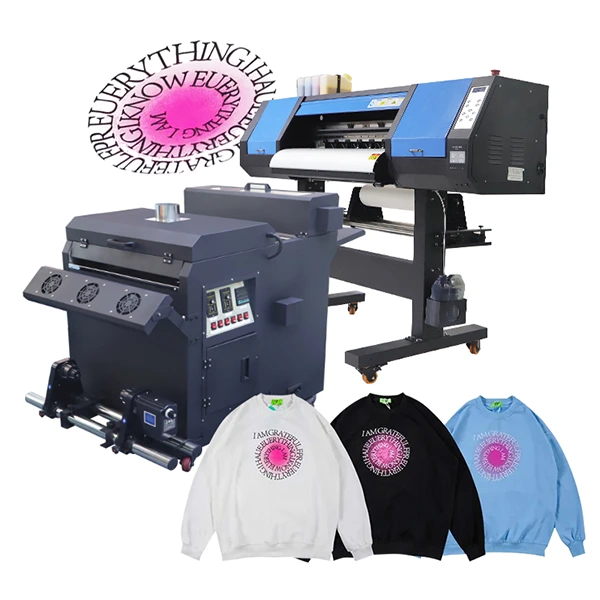
ข้อดีของการพิมพ์ DTF
- วิธีการพิมพ์ที่ประหยัดต้นทุน
การพิมพ์ DTF ถือเป็นประสิทธิภาพที่คุ้มค่า, ส่วนใหญ่เกิดจากอุปกรณ์ที่ต่ำกว่าและต้นทุนหมึกเมื่อเทียบกับการพิมพ์ UV DTF. สิ่งนี้ทำให้ธุรกิจขนาดเล็กและบุคคลที่ต้องการเข้าร่วมในอุตสาหกรรมการพิมพ์.
- ความเก่งกาจในแง่ของพื้นผิวที่เข้ากันได้
เช่นการพิมพ์ UV DTF, การพิมพ์ DTF ช่วยให้สามารถพิมพ์บนพื้นผิวต่างๆ, รวมถึงผ้า, เซรามิกส์, พลาสติก, และอื่น ๆ. ความเก่งกาจนี้ขยายช่วงของผลิตภัณฑ์ที่สามารถผลิตได้โดยใช้การพิมพ์ DTF.
- ความสามารถในการบรรลุสีสันสดใสและรายละเอียดที่ละเอียด
การพิมพ์ DTF สามารถบรรลุสีสันสดใสและสดใส, รวมถึงรายละเอียดที่ดี, ทำให้เหมาะสำหรับการออกแบบที่ซับซ้อนและงานศิลปะที่ซับซ้อน.
- ใช้งานง่ายและทำความสะอาด
เครื่องพิมพ์ DTF เป็นมิตรกับผู้ใช้, ต้องการการตั้งค่าและการบำรุงรักษาขั้นต่ำ. นอกจากนี้, กระบวนการทำความสะอาดค่อนข้างง่าย, ช่วยให้การทำงานที่ราบรื่นขึ้นและลดเวลาหยุดทำงาน.
ข้อจำกัดของการพิมพ์ DTF
- ขอบเขตสีที่ จำกัด เมื่อเทียบกับ UV DTF
ในขณะที่การพิมพ์ DTF สามารถบรรลุสีสันสดใส, ช่วงสีของมันอาจจะแคบกว่าเมื่อเทียบกับ UV DTF, การ จำกัด ช่วงของเฉดสีและโทนสีที่สามารถทำซ้ำได้.
- เวลาผลิตนานขึ้น
การพิมพ์ DTF อาจต้องใช้ขั้นตอนเพิ่มเติมสำหรับการถ่ายโอนการออกแบบไปยังสารตั้งต้น, ซึ่งอาจส่งผลให้เวลาการผลิตนานขึ้นเมื่อเทียบกับการพิมพ์ UV DTF.
- อาจต้องใช้ขั้นตอนเพิ่มเติมสำหรับผ้าบางอย่าง
ผ้าบางอย่างอาจต้องใช้กระบวนการบำบัดล่วงหน้าก่อนพิมพ์ด้วย หมึก DTF. สิ่งนี้สามารถเพิ่มความซับซ้อนและเวลาให้กับกระบวนการพิมพ์โดยรวม.
ยูวี DTF กับ DTF: การเปรียบเทียบ
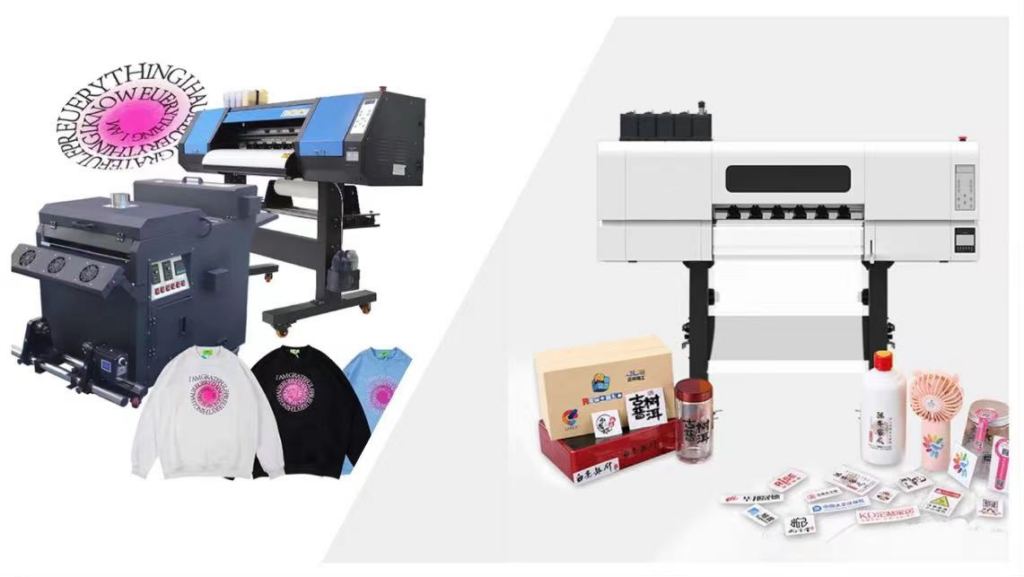
ก. การเปรียบเทียบคุณภาพการพิมพ์
ความละเอียดและความคมชัด
ทั้งการพิมพ์ UV DTF และ DTF สามารถสร้างภาพพิมพ์ที่มีความละเอียดสูงพร้อมรายละเอียดที่คมชัด. อย่างไรก็ตาม, การพิมพ์ UV DTF อาจให้ผลลัพธ์ที่คมชัดขึ้นเล็กน้อยเนื่องจากกระบวนการบ่ม UV, ซึ่งช่วยเพิ่มความคงทนของหมึก.
ความแม่นยำของสีและความมีชีวิตชีวา
การพิมพ์ UV DTF โดยทั่วไปมีขอบเขตสีที่กว้างขึ้น, ช่วยให้การทำซ้ำสีที่แม่นยำยิ่งขึ้นและการออกแบบที่มีชีวิตชีวา. การพิมพ์ DTF, ในขณะที่มีสีสันสดใส, อาจมีข้อ จำกัด ในการบรรลุเฉดสีและโทนบางอย่าง.
ข. ประเภทของสารตั้งต้น
ตัวเลือกผ้า
ทั้งการพิมพ์ UV DTF และ DTF สามารถใช้ในการพิมพ์บนผ้าประเภทต่างๆ, รวมถึงผ้าฝ้าย, โพลีเอสเตอร์, และผสมผสาน. อย่างไรก็ตาม, การพิมพ์ DTF อาจต้องใช้ขั้นตอนเพิ่มเติมหรือการรักษาล่วงหน้าสำหรับผ้าบางชนิดเพื่อให้แน่ใจว่าการยึดเกาะของหมึกที่ดีที่สุด.
การพิมพ์บนพื้นผิวแข็ง
เมื่อพูดถึงการพิมพ์บนพื้นผิวที่แข็งเช่นแก้ว, พลาสติก, หรือเซรามิกส์, การพิมพ์ UV DTF เป็นตัวเลือกที่ต้องการ. กระบวนการบ่ม UV ทำให้มั่นใจได้ว่าการยึดมั่นในหมึกที่ยอดเยี่ยมและความทนทานบนพื้นผิวเหล่านี้.
ค. ความเร็วในการผลิตและประสิทธิภาพ
การพิมพ์ UV DTF ให้เวลาการผลิตที่เร็วขึ้นเมื่อเทียบกับการพิมพ์ DTF. การอบแห้งแบบทันทีของหมึก UV DTF ช่วยลดความจำเป็นในการอบแห้งระยะเวลาที่ขยายออกไป, ช่วยให้เวิร์กโฟลว์มีประสิทธิภาพมากขึ้น.
ดี. การเปรียบเทียบค่าใช้จ่าย
การพิมพ์ UV DTF โดยทั่วไปมีค่าใช้จ่ายล่วงหน้าสูงขึ้นเนื่องจากหมึกและอุปกรณ์ UV พิเศษที่จำเป็น. การพิมพ์ DTF, ในทางกลับกัน, เสนอจุดเริ่มต้นที่ประหยัดต้นทุนมากขึ้นสำหรับผู้ที่เริ่มต้น
การพิมพ์.
อี. ข้อกำหนดการบำรุงรักษาและการบำรุงรักษา
ทั้งอุปกรณ์การพิมพ์ UV DTF และ DTF ต้องการการบำรุงรักษาและการบำรุงรักษาเป็นประจำ. อย่างไรก็ตาม, เครื่องพิมพ์ UV DTF อาจต้องใช้การทำความสะอาดบ่อยขึ้นและการเปลี่ยนหมึกเนื่องจากธรรมชาติของหมึก UV.
DTF กับ UV DTF, ซึ่งดีกว่า?
| พิมพ์ | การพิมพ์ DTF | การพิมพ์ยูวี DTF |
| เทคโนโลยี | พิมพ์บนฟิล์มที่ถูกกดความร้อนลงบนวัสดุ. | รวมเทคโนโลยี DTF เข้ากับแสง UV เพื่อรักษาหมึกทันที. |
| หมึก | ใช้หมึก CMYK+ White, พิมพ์บนฟิล์มสัตว์เลี้ยงที่ชัดเจน. | ใช้หมึก UV, พิมพ์บนฟิล์มสัตว์เลี้ยงที่ชัดเจน. |
| แอปพลิเคชัน | ฝ้าย, โพลีเอสเตอร์, ผ้าฝ้ายโพลีผสม, หนัง, ไนลอน, และอื่น ๆ. | ฝ้าย, โพลีเอสเตอร์, ผ้าฝ้ายโพลีผสม, หนัง, ไนลอน, พลาสติก, ไม้, โลหะ, และแม้แต่แก้ว, และอื่น ๆ. |
| รายละเอียด | คุณภาพของภาพและรายละเอียดที่สูงมาก. | คุณภาพและรายละเอียดของภาพสูง, แม้ว่ากระบวนการ UV อาจส่งผลกระทบเล็กน้อย. |
| ความทนทาน | มีความทนทานสูง, แต่อาจไม่นานเท่าที่ UV DTF. | มีความทนทานสูง, กระบวนการ UV ขยายอายุการใช้งานที่ยืนยาว. |
DTF กับ UV DTF Table Table
เมื่อใดควรเลือกการพิมพ์ UV DTF
การพิมพ์ UV DTF เป็นตัวเลือกที่เหมาะสมสำหรับธุรกิจหรือบุคคลที่กำลังมองหางานพิมพ์คุณภาพสูงที่มีสีสันสดใสและรายละเอียดที่คมชัด. เหมาะสำหรับผู้ที่จัดลำดับความสำคัญของเวลาการผลิตที่เร็วขึ้น, จำเป็นต้องพิมพ์บนพื้นผิวที่แข็ง, และสามารถรองรับค่าใช้จ่ายเริ่มต้นที่สูงขึ้นได้.
เมื่อใดควรเลือกการพิมพ์ DTF
การพิมพ์ DTF เป็นตัวเลือกที่คุ้มค่าสำหรับผู้ที่เริ่มต้นในอุตสาหกรรมการพิมพ์. ให้ความเก่งกาจในแง่ของพื้นผิวที่เข้ากันได้และใช้งานง่ายและบำรุงรักษาง่าย. แนะนำให้พิมพ์ DTF สำหรับผู้ที่จัดลำดับความสำคัญของประสิทธิภาพต้นทุน, ความเก่งกาจในวัสดุการพิมพ์, และความเรียบง่ายในการใช้งาน.
การเลือกวิธีการพิมพ์ที่เหมาะสม

คุณภาพการพิมพ์ที่ต้องการ
พิจารณาระดับความคมชัดของภาพ, ความแม่นยำของสี, และความมีชีวิตชีวาที่จำเป็นสำหรับการพิมพ์ของคุณ. การพิมพ์ UV DTF เก่งในพื้นที่เหล่านี้, ในขณะที่การพิมพ์ DTF มีตัวเลือกที่คุ้มค่ายิ่งขึ้นพร้อมกับคุณภาพการพิมพ์ที่น่านับถือ.
ประเภทของวัสดุที่จะพิมพ์บน
คำนึงถึงความหลากหลายของสารตั้งต้นที่คุณวางแผนจะพิมพ์. หากคุณคาดว่าจำเป็นต้องพิมพ์บนพื้นผิวหรือวัสดุที่อาจต้องใช้การรักษาล่วงหน้า, การพิมพ์ UV DTF เป็นตัวเลือกที่ดีกว่า.
ปริมาณการผลิตและกำหนดเวลา
หากคุณมีกำหนดเวลาการผลิตที่เข้มงวดหรือข้อกำหนดการพิมพ์ปริมาณมาก, เวลาการผลิตที่รวดเร็วของ UV DTF อาจเหมาะสมกว่า. อย่างไรก็ตาม, หากปริมาณการผลิตไม่ใช่ปัญหาหลัก, การพิมพ์ DTF เสนอทางเลือกที่มีความสามารถ.
งบประมาณที่มีอยู่
พิจารณางบประมาณที่มีอยู่ของคุณสำหรับอุปกรณ์, หมึก, และการบำรุงรักษา. การพิมพ์ UV DTF โดยทั่วไปต้องใช้การลงทุนล่วงหน้าที่สูงขึ้น, ในขณะที่การพิมพ์ DTF นำเสนอจุดเริ่มต้นที่คุ้มค่ากว่า. เช่นกัน, สิ่งสำคัญคือต้องเลือกไฟล์ ผู้ผลิตเครื่องพิมพ์ผ้าที่เชื่อถือได้.
บทสรุป
สรุปแล้ว, การพิมพ์ UV DTF และการพิมพ์ DTF เป็นสองวิธีที่แตกต่างกันซึ่งมีคุณภาพของภาพที่ยอดเยี่ยมและความเก่งกาจ.
การพิมพ์ UV DTF เก่งในแง่ของสีสันสดใส, รายละเอียดที่คมชัด, และความสามารถในการพิมพ์บนพื้นผิวต่างๆ, ทำให้เหมาะสำหรับธุรกิจที่มีการจัดสรรงบประมาณที่สูงขึ้นและความต้องการการพิมพ์เฉพาะ. การพิมพ์ DTF, ในทางกลับกัน, ให้จุดเริ่มต้นที่คุ้มค่าสำหรับธุรกิจขนาดเล็กและบุคคลที่กำลังมองหาความหลากหลาย, ความเรียบง่าย, และใช้งานง่าย.
ในที่สุด, ทางเลือกระหว่างการพิมพ์ UV DTF และการพิมพ์ DTF ขึ้นอยู่กับปัจจัยต่าง ๆ เช่นข้อกำหนดการพิมพ์, ความหลากหลายของสารตั้งต้น, ปริมาณการผลิต, และงบประมาณที่มีอยู่. โดยการพิจารณาปัจจัยเหล่านี้และทำความเข้าใจจุดแข็งและข้อ จำกัด ของแต่ละวิธี, คุณสามารถตัดสินใจอย่างชาญฉลาดและบรรลุผลการพิมพ์ที่โดดเด่น.

